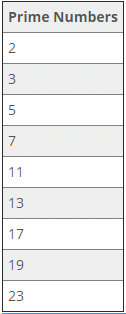Class 6 Exam > Class 6 Questions > What is co prime and prime factorization?
Start Learning for Free
What is co prime and prime factorization?
Verified Answer
What is co prime and prime factorization?
When two numbers (they may not be prime) do not have any common factor other than one between them they are called co-prime or relatively prime.
It is obvious that two prime numbers are always co-prime. For example, 17 and 23However, even two composite numbers can also be co-prime or relatively prime. For example 16 and 25 do not have any common factor other than one. Similarly 84 and 65 do not have any common factor and are hence co-prime.
Factorization
Have you ever seen the show Fear Factor? It required contestants to face a variety of fear inducing stunts in order to win the grand prize of $50,000. At the end of the show, the host would say to the winner, 'Evidently, fear is not a factor for you!' What exactly does that mean? Well, it means that fear doesn't play a part in their actions and decisions. So, then a 'factor' is something that affects an outcome. In mathematics, factors are the numbers that multiply to create another number.
The prime factorization of a number, then, is all of the prime numbers that multiply to create the original number. It would be pretty difficult to perform prime factorization if we didn't first refresh our memory on prime numbers. With that being said, a prime number is a number that can only be divided by one and itself. Here are a few prime numbers to get you started:

They might seem like a random bunch of numbers, but they do have that one very important thing in common; they are only divisible by one and themselves.
 This question is part of UPSC exam. View all Class 6 courses
This question is part of UPSC exam. View all Class 6 courses
Most Upvoted Answer
What is co prime and prime factorization?
Co-Prime and Prime Factorization
Co-Prime Numbers:
Co-prime numbers, also known as relatively prime numbers, are integers that have no common factors other than 1. In simpler terms, two numbers are co-prime if their greatest common divisor (GCD) is 1. For example, 8 and 9 are co-prime because the only common factor they have is 1.
Prime Factorization:
Prime factorization is the process of breaking down a composite number into its prime factors. A prime factor is a prime number that divides the original number without leaving a remainder. For instance, the prime factorization of 24 is 2 x 2 x 2 x 3, where 2 and 3 are prime factors of 24.
Steps to Find Prime Factorization:
- Start by dividing the number by the smallest prime number (2) until it can no longer be divided evenly.
- Move on to the next prime number and repeat the division process until the result is 1.
- Write down all the prime factors obtained in the process to express the number as a product of primes.
Importance of Prime Factorization:
- Prime factorization is crucial in various mathematical calculations, including simplifying fractions, finding the greatest common divisor, and solving problems related to number theory.
- It helps in understanding the fundamental building blocks of a number and its unique representation as a product of primes.
In conclusion, co-prime numbers have no common factors other than 1, while prime factorization involves breaking down a number into its prime factors. Mastering these concepts is essential for tackling advanced mathematical problems efficiently.
Co-Prime Numbers:
Co-prime numbers, also known as relatively prime numbers, are integers that have no common factors other than 1. In simpler terms, two numbers are co-prime if their greatest common divisor (GCD) is 1. For example, 8 and 9 are co-prime because the only common factor they have is 1.
Prime Factorization:
Prime factorization is the process of breaking down a composite number into its prime factors. A prime factor is a prime number that divides the original number without leaving a remainder. For instance, the prime factorization of 24 is 2 x 2 x 2 x 3, where 2 and 3 are prime factors of 24.
Steps to Find Prime Factorization:
- Start by dividing the number by the smallest prime number (2) until it can no longer be divided evenly.
- Move on to the next prime number and repeat the division process until the result is 1.
- Write down all the prime factors obtained in the process to express the number as a product of primes.
Importance of Prime Factorization:
- Prime factorization is crucial in various mathematical calculations, including simplifying fractions, finding the greatest common divisor, and solving problems related to number theory.
- It helps in understanding the fundamental building blocks of a number and its unique representation as a product of primes.
In conclusion, co-prime numbers have no common factors other than 1, while prime factorization involves breaking down a number into its prime factors. Mastering these concepts is essential for tackling advanced mathematical problems efficiently.

|
Explore Courses for Class 6 exam
|

|
Question Description
What is co prime and prime factorization? for Class 6 2025 is part of Class 6 preparation. The Question and answers have been prepared according to the Class 6 exam syllabus. Information about What is co prime and prime factorization? covers all topics & solutions for Class 6 2025 Exam. Find important definitions, questions, meanings, examples, exercises and tests below for What is co prime and prime factorization?.
What is co prime and prime factorization? for Class 6 2025 is part of Class 6 preparation. The Question and answers have been prepared according to the Class 6 exam syllabus. Information about What is co prime and prime factorization? covers all topics & solutions for Class 6 2025 Exam. Find important definitions, questions, meanings, examples, exercises and tests below for What is co prime and prime factorization?.
Solutions for What is co prime and prime factorization? in English & in Hindi are available as part of our courses for Class 6.
Download more important topics, notes, lectures and mock test series for Class 6 Exam by signing up for free.
Here you can find the meaning of What is co prime and prime factorization? defined & explained in the simplest way possible. Besides giving the explanation of
What is co prime and prime factorization?, a detailed solution for What is co prime and prime factorization? has been provided alongside types of What is co prime and prime factorization? theory, EduRev gives you an
ample number of questions to practice What is co prime and prime factorization? tests, examples and also practice Class 6 tests.

|
Explore Courses for Class 6 exam
|

|
Signup for Free!
Signup to see your scores go up within 7 days! Learn & Practice with 1000+ FREE Notes, Videos & Tests.























